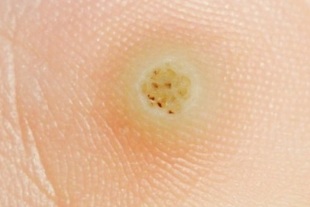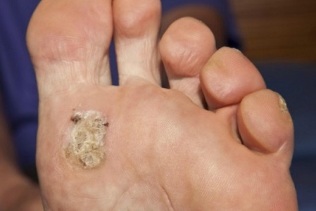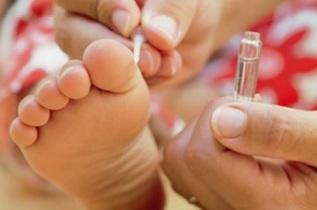
If there are hard and rough pimples on the soles of the feet, and the top is rough, it may be a wart or or. The difference is significant, mainly in source and treatment. Warts grow like spikes on the inner layer of the foot, which can cause severe pain. If the shoe is damaged and inflamed by the shoe, the doctor recommends removing it.
Appearance of protrusions on the soles of the feet
The main part of common warts on the feet grows inward and enters the dermis. The reason is that from the outside, the tumor is squeezed by a hard surface: the shoes, the various coatings on which we walk. New growth cells emerge from the soft tissues of the skin. In photos of plantar warts, dense plaques or rollers can be seen from the outside. The surface of the stratum has no dermatoglyph and is composed of scales of keratinous material. The adjacent skin changes: it becomes denser and is covered by a layer of keratin.
The appearance of plantar warts:
- A nodule or plaque raised 1–5 mm above the epidermis; The shape of
- is circle, oval or polygon;
- The surface feels hard and rough;
- The color is pink, yellow-white or gray;
- The stratum diameter ranges from 1 to 20 mm;
- The nipple pattern is missing;
- The edges are well defined.
Warts on the feet are characterized by acute pain that interferes with walking, until temporary disability.

accumulate in areas exposed to intense stress and sweat. Typical positioning of warts on the sole: heel, sole and toe. Painful and difficult to remove structures appear on the edge of the nail and under the nail plate. In all types of warts, there are blood vessels to feed living tissues and cells multiply. Small black spots-blood clots in capillaries are visible on the surface; they may bleed when cutting the stratum corneum.
Plantar warts are most common in school-age children. In approximately 30% of patients, this type of formation disappears on its own within the first year. However, it is recommended to start treatment when the first symptoms appear, especially if there is a high risk of if the wart is injured or the people around you get infected. Infection is also dangerous. When a group of tissues appear in an area, individual papules merge into mosaic patches.
Warts-papillomavirus manifestations
When wearing tight and uncomfortable shoes, the skin on the feet is usually damaged, compressed and sweaty. If there are thin-walled blisters with transparent liquid inside, they are corn. Sometimes a layer of keratin is formed on the surface, but even so, it still retains the typical skin lines.
First of all, the appearance of warts on the soles of the feet is not noticeable or is considered to be the formation of callus. The surface of the stratum must be carefully observed and attention to the characteristic signs. This is severe keratinization, no skin lines, and soreness when the surrounding skin is pressed. These are the results of the active reproduction of papillomavirus in epithelial cells.
Causes of plantar warts:
- Papillomavirus (HPV) infection;
- Weakens local and general immune defenses;
- Activates the virus and penetrates into epithelial cells;
- Increase the proliferation and rapid keratinization of infected cells.
HPV is spread through family and sexual contact. Infectious substances can penetrate even through minor damage to the skin and mucous membranes: cracks, cuts, tears.
Papillomavirus types 1, 2, 4, 27, and 57 mainly infect cells located in the skin of the feet. The type of plantar growth that the virus originated from is simple (ordinary, vulgar). According to the International Classification of Diseases, they are infectious diseases and parasitic diseases. ICD-10 category: "Viral infection characterized by damage to the skin and mucous membranes".
Simple warts are benign epithelial tumors. They do not pose a health hazard initially. Sometimes this growth undergoes malignant transformation into a cancerous tumor. This process is usually triggered by HPV types, which have identified a high risk of cancer.
Foot warts treatment
After infection, the incubation period begins: the papilloma virus invades the cell and "reformats" its reproduction and development. Usually, the infection is latent, and in this inactive state, it can exist throughout the entire life of the organism. In this case, immunity can suppress the papilloma virus and enter sleep mode without special treatment.
Plantar warts may appear 3-10 years after infection or several weeks after infection, and then disappear within the first or two years.
Not everyone is ready to wait, expecting to heal spontaneously and clean the skin from growth. Many people see a doctor as the first sign of HPV infection. Dermatologists recommend the use of modern methods of removing warts and recommend antiviral treatments to strengthen the skin and the immune system of the entire body.
If the treatment is to be appropriately selected, it is necessary to determine the type of HPV, and then the doctor prescribes some other studies. A biopsy is performed to collect histological material and analysis is performed to determine antibodies against papillomavirus.
Processing options:
- Use special medicine for plant warts. Dissolution and shedding of dead cells occur
- Laser excises simple tumors and forms abs, and heals under this under. 7-10 days after the operation, the crust disappeared.
- Freeze molding with liquid nitrogen. Large warts can be removed in a few steps. When exposed to low temperatures, bubbles will appear.
- Electrocoagulation using electrodes, through which high-frequency current is applied to destroy pathological tissues. The painful process is accompanied by a strong smell of burning skin.
- Surgical resection
- Drug injection
At the beginning of treatment, it is recommended to use a special cast at home. After using warm water to soften the warts on the feet, and using nail clippers and pumice stones to remove them from the keratinization layer, you can use this economical treatment. Then apply the patch. The treatment course lasts 1-3 months on average.
Prevention
Papillomavirus can exist in the environment for a long time. You must keep your feet clean and do not wear shoes, especially in public changing rooms, bathrooms and swimming pools. Special slippers must be used to protect the soles of the feet from surfaces contaminated by other people’s skin particles. In addition, please do not wear other people's socks and shoes.
Do not scrape the wart, otherwise similar growth will appear on other parts of the leg.
Papillomavirus is extremely contagious. Sterilize accessories for daily hygiene and pharmaceutical applications. Socks and foot towels should be washed thoroughly with hot water, and scissors, nail files, and pumice should be disinfected. After touching educational content and various medical procedures, please wash your hands with soap and water













































































